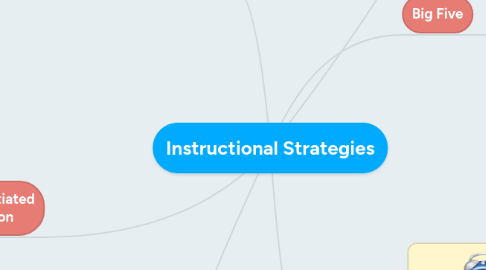Instructional Strategies
by Valeria Landa


1. Differentiated Instruction
1.1. Content
1.1.1. Different levels of reading or resource
1.1.2. Small group instruction
1.1.3. Webquests
1.1.3.1. Periodic Table Webquest Activity
1.2. Product
1.2.1. Activity choice boards
1.2.2. Tiered activities
1.2.3. Mixed readiness groups
1.3. Process
1.3.1. Independent study
1.3.2. Varied rubrics
1.3.3. Interest-based investigations
2. Universal Design for Learning
2.1. Engagement
2.2. Representation
2.3. Expression
3. Grade 9 Cell Cycle Example
3.1. Stations
3.2. Choice of centers
3.3. Assessment for learning
3.4. Groups
4. Pros
4.1. Students become independent learners
4.1.1. Success continues in preceding grades
4.2. Student motivation
4.3. Student achievement
5. Big Five
5.1. Direct Instruction
5.1.1. SMART Boards
5.1.2. Videos
5.1.2.1. Periodic Videos
5.1.2.2. Veritasium
5.2. Indirect Instruction
5.2.1. Case studies
5.2.2. Guided Inquiry
5.3. Experimental
5.3.1. Field Observation
5.3.2. Discovery
5.3.3. Simulations
5.3.3.1. Gizmos
5.3.3.2. PhET
5.4. Individual Study
5.4.1. Self study activities
5.4.2. Journal writing
5.5. Collaboration
5.5.1. Problem solving groups
5.5.2. Lab groups
5.5.3. Whole class activities

